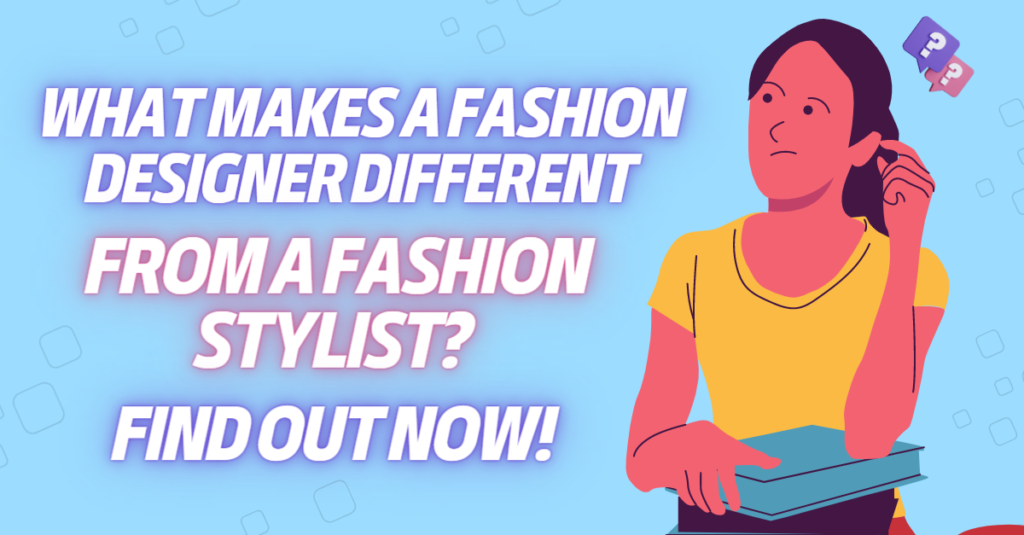What Makes a Fashion Designer Different From a Fashion Stylist? Find Out Now!
Fashion is a vast industry that has many different roles within it. Two of the most prominent roles in the industry are fashion designers and fashion stylists. While they may seem like similar positions, they actually have different roles and responsibilities. In this article, we will explore the differences between fashion designers and fashion stylists and what makes them unique.
Fashion Designers
A fashion designer is an individual who creates clothing and accessories, ranging from haute couture to ready-to-wear apparel. They create unique designs that are influenced by fashion trends, culture, and history. Fashion designers typically work with textiles, fabrics, and other materials to create garments that are visually appealing, functional, and wearable.
The role of a fashion designer requires a strong understanding of fashion trends and the ability to predict future trends. They must be able to create innovative designs that appeal to the target audience, while also maintaining practicality and wearability. A fashion designer must also be able to communicate their ideas effectively and work collaboratively with a team to bring their designs to life.
Education and Training
Most fashion designers have a degree in fashion design, textiles, or a related field. A formal education in fashion design is essential for those who want to pursue a career in this field. Coursework in fashion design typically includes classes in textiles, sketching, pattern-making, and garment construction.
In addition to formal education, aspiring fashion designers often gain experience through internships or apprenticeships with established fashion houses or designers. This hands-on experience allows them to learn about the industry, gain valuable contacts, and build their portfolio.
Skills and Qualities
Fashion designers must possess a variety of skills and qualities to succeed in the industry. These include:
- Creativity: Fashion designers must have a unique and innovative vision to create designs that are both visually appealing and functional.
- Technical skills: Fashion designers must have a strong understanding of textiles, pattern-making, and garment construction.
- Attention to detail: Designers must have an eye for detail and be able to spot even the smallest imperfections in their work.
- Communication skills: Fashion designers must be able to communicate their ideas effectively to clients, team members, and manufacturers.
- Business acumen: A successful fashion designer must have an understanding of the business side of the fashion industry, including sales, marketing, and budgeting.
- Time management: Fashion designers must be able to manage their time effectively to meet deadlines and ensure timely delivery of their products.
Fashion Stylists
A fashion stylist, on the other hand, is an individual who helps clients create outfits that are stylish and visually appealing. They work with a variety of clients, including celebrities, models, and everyday people, to create looks that are both fashionable and practical.
The role of a fashion stylist requires a deep understanding of fashion trends, body types, and personal style. They must be able to create outfits that not only look good but also make the client feel confident and comfortable. Fashion stylists must also be able to communicate effectively with clients to understand their needs and preferences.
Education and Training
Unlike fashion designers, fashion stylists do not require formal education or training to enter the field. However, many fashion stylists do have a background in fashion, such as a degree in fashion merchandising or fashion design.
In addition to formal education, fashion stylists often gain experience through internships or apprenticeships with established fashion stylists or fashion houses. This hands-on experience allows them to learn about the industry, gain valuable contacts, and build their portfolio.
Skills and Qualities
Fashion stylists must possess a variety of skills and qualities to succeed in the industry. These include:
- Creativity: Fashion stylists must have a unique and innovative vision to create outfits that are stylish and visually appealing.
- Communication skills: Fashion stylists must be able to communicate effectively with clients to understand their needs and preferences.
- Attention to detail: Stylists must have an eye for detail and be able to spot even the smallest imperfections in their work.
- Fashion knowledge: A successful fashion stylist must have a deep understanding of fashion trends, body types, and personal style.
- Interpersonal skills: Fashion stylists must be able to build strong relationships with clients, vendors, and other professionals in the fashion industry.
- Organization skills: Stylists must be able to manage their time effectively and keep track of multiple clients and projects at once.
Fashion designers vs. Fashion Stylists: What’s the difference?
The main difference between fashion designers and fashion stylists is their focus. Fashion designers focus on creating new designs, while fashion stylists focus on working with existing designs to create a specific look or style.
Fashion designers need to have a range of skills related to design, including knowledge of textiles, color theory, and garment construction. They also need to be able to use computer-aided design (CAD) software to create their designs and communicate their ideas effectively. Fashion designers also need to have a strong understanding of trends and be able to predict what their target audience will want.
Fashion stylists, on the other hand, need to have a strong understanding of current trends and be able to work with a range of different clothing styles and body types. They also need to have excellent communication and organizational skills to work effectively with other members of a team.
Another difference between fashion designers and fashion stylists is their working environment. Fashion designers often work in design studios or manufacturing facilities, where they can create and develop their designs. Fashion stylists, on the other hand, work on location, such as on photoshoots or at events, where they can style their clients or models.
Fashion designers and fashion stylists also have different education requirements. Fashion designers typically need a bachelor’s degree in fashion design or a related field, along with experience in the industry. Fashion stylists, on the other hand, may not need a degree, but they often have experience working in the fashion industry and may have completed a fashion styling course or program.
It’s worth noting that there can be some overlap between the roles of fashion designers and fashion stylists, especially in smaller fashion companies or startups. In these cases, a fashion designer may also take on the role of a fashion stylist, or a fashion stylist may also contribute to the design process.
Conclusion
In conclusion, while fashion designers and fashion stylists may seem similar, there are significant differences between the two professions. Fashion designers create clothing and accessories, while fashion stylists help clients create outfits and looks. While both professions require creativity, attention to detail, and communication skills, fashion designers need technical skills in textiles, pattern-making, and garment construction, while fashion stylists need strong interpersonal skills and fashion knowledge. Understanding the differences between these two professions can help individuals make informed decisions about their career paths in the fashion industry.

My name is Rohit Vagh and I’m a content writer specializing in fashion and lifestyle. I have three years of experience in this field and have written various articles. My writing style is creative and engaging, and I strive to create content that resonates with my readers. I have a deep passion for fashion and am constantly researching the latest trends and styles to make sure my readers are up to date. I’m excited to continue my career in blogging, and I’m always looking for new opportunities in the fashion and lifestyle space.





